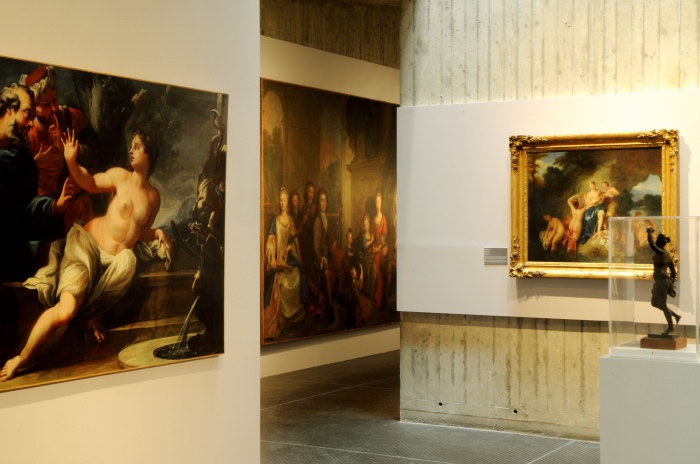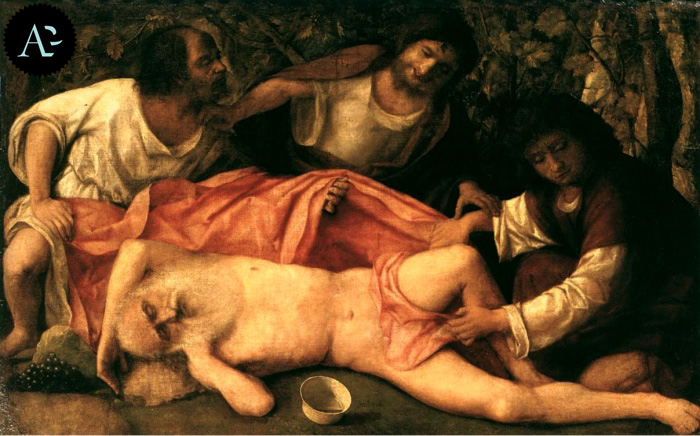The drunkenness of Noah by Giovanni Bellini
The Drunkenness of Noah. The celebrations of the 500th anniversary of the death of Giovanni Bellini have brought to Venice a masterpiece such as The Drunkenness of Noah on exhibition at the Museo Correr. The painting hasn’t come back to Italy for many years.
The painting, kept in the Musée des Beaux-Arts et Archéologie of Besançon (the Museum of Fine Arts and Archaeology of Besançon) since 1895, is probably the last masterpiece by the old master and was attributed to him during the 20th century, after a 400-years discussion between art critics and historians.

Little is known about the The Drunkenness of Noah before its arrival at the Museum of Besançon. It was added to the museum collection in 1896, after Jean Gigoux, artist and collector, donated his whole collection of pieces of art. The work was mentioned for the first time even in the inventory made after Jean Gigoux’s death, and for a long time its authorship would be a subject matter for discussions, second thoughts and doubts.
Including Bellini, the painting was attributed to Giorgione, Lorenzo Lotto and Titian. In 1927 the art critic Roberto Longhi and in 1957 the American Bernard Berenson confirmed the canvas was painted by Giovanni Bellini.
The subject of the painting is taken from the Book of Genesis (9.18 – 27) and represents Noah, drunk and sleeping naked in his vineyard, discovered by his son Ham, who laughs when he sees his father. Then Ham informs his brothers who soon try to cover their old father. For his derision, Ham will be damned by Noah, and will condemned to slavery together with his descendants.
This family tragedy, symbol of the reinstatement of a hierarchical order in the world after the Universal Flood, was popular among the Venetians because it is also the subject of a mosaic inside the Basilica of Saint Mark and it is on a 15th -century capital on the facade of the Doge’s Palace, which are the main buildings in Venice.
Why is The Drunkenness of Noah so extraordinary?
Firstly, it is a rare theme in the history of painting but it was also the first time Giovanni Bellini dealt with a subject taken from the Old Testament and at the end of his career.
The painting is full of symbolic meanings: wine is symbol of Eucharist and mocked Noah anticipates mocked Christ in the New Testament. The scene is represented as a bas-relief; the three Noah’s sons look at each other and their gazes tell the whole story.
The painting would also be a political invitation to peace in a moment Venice had to defend itself from the League of Cambrai, which wanted to subjugate the Serenissima to the Papal States.
The Drunkenness of Noah by Giovanni Bellini is a complex painting, full of symbols and described with a new style used by Giovanni Bellini. He, although he was old, was influenced both by his young pupil Giorgione, and by the great revolution which was about to affirm itself and of which Titian will be the main representative.




Come sempre un’ ottima descrizione che lascia in chi legge la voglia di andare immediatamente ad ammirarlo.
Grazie Caterina per il tuo lavoro,
Antonio
Grazie a te Antonio per aver letto il post e per il complimento
Forse avresti dovuto citare le fonti. Per esempio i miei due saggi sul dipinto. Stefano Coltellacci
Trattandosi di un blog divulgativo non costruisco mai i post come dei saggi e, quindi, non ho mai la necessità di citare le fonti perché descrivo le opere secondo le conoscenze che sono riferite in qualsiasi libro di storia dell’arte. In questo caso, tra l’altro, ho descritto l’opera secondo quanto riferito durante la conferenza stampa di una mostra tenutasi al Museo Correr e non mi pare proprio che i suoi saggi siano stati citati.
Comunque, non avendo trovato alcunché in rete, la invito a scrivere un commento inserendo i titoli dei saggi che lei ha scritto e magari un link, per dare modo a chiunque di leggerli.